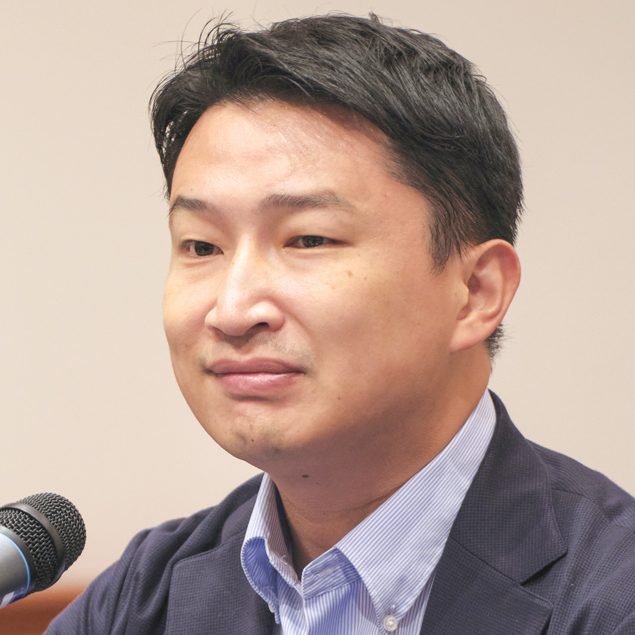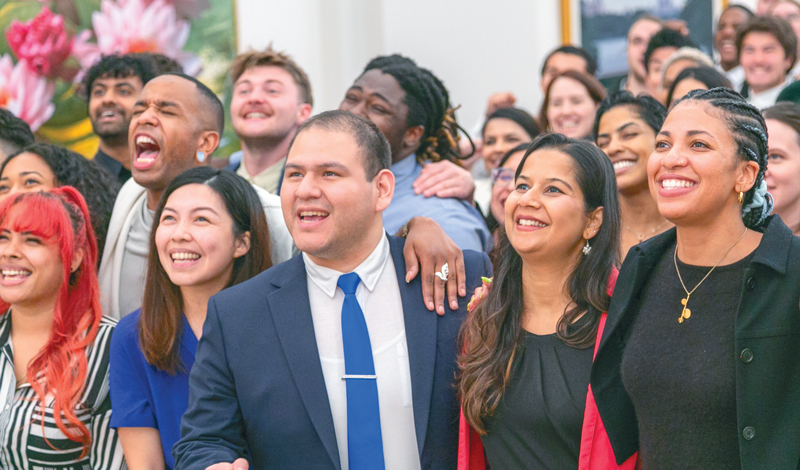SGI Youth Leader Mitsuo Nishikata gave the following words at the Tri-state leaders meeting held on Sept. 16, 2024, at the SGI-USA New York Culture Center.

by Mitsuo Nishikata
SGI Youth Leader
Congratulations on holding this meeting for the leaders of Ever-Victorious New York!
I feel such appreciation to visit the U.S. with SGI Vice President Yoshiki Tanigawa at this crucial moment as we take full responsibility as Ikeda Sensei’s disciples to propel worldwide kosen-rufu.
I was born and raised in Ever-Victorious Kansai. My grandpa joined the Soka Gakkai in 1956 when Sensei was leading the Osaka Campaign.[1] At the time, my grandpa was suffering from a serious illness. Immediately after joining, he would take his young daughter, my mom, all around the city to do shakubuku, and in doing so, his health improved and he lived until age 74.
Our family pride is that my grandpa and mom attended the Osaka Rally[2] on July 17, 1957, after Sensei was released from prison and declared with the roar of a lion: “Those who strive tenaciously in faith, steadfastly upholding the Gohonzon, will definitely emerge victorious.”[3]
Now, youth around the world are powerfully advancing kosen-rufu as Sensei’s disciples based on the motto, “One World, With Sensei!”
The youth of Japan are aiming toward Ikeda Sensei’s first memorial on Nov. 15 to engage in dialogues with the shakubuku spirit, based on the vow to “establish the correct teaching for the peace of the land.”
Personally, I helped a 20-year-old friend receive the Gohonzon in December, one month after Sensei’s passing. Recently, this friend passed the Introductory Exam and has been studying Buddhism. I’ve seen how she has naturally started sharing Buddhism as her conviction develops!
Sensei writes: “First one individual stands up, becoming the starting point, then that person speaks to another—this most basic connection between individuals is the foundation for the growth of kosen-rufu at all times and in all places, on into the future.”[4]
This means to me that regardless of our circumstances, we should take courageous action with a stand-alone spirit rooted in the same vow as our mentor. As the saying goes, “A lion seeks no companion.” Sensei has taught us through his campaigns that by being the first to stand up, one person after another will be inspired and awaken to their mission as a Bodhisattva of the Earth.
In addition, it is necessary to stand up with deep faith in the limitless power of each individual and develop the ability to persistently cherish others.
I had an unforgettable experience that has become my prime point with Sensei. In fall 2006, during my senior year at Soka University, Sensei received his 200th honorary doctorate. To commemorate this honor, the student division held a festival to celebrate our mentor’s achievement, and I was in charge behind the scenes.
The ceremony included several student performances, which visibly brought Sensei so much joy. After applauding and praising the performances, he turned to me and removed the Soka University pin from his suit lapel and tried to secure it to mine. The pin wasn’t quite penetrating the suit material, and the 3,000 audience members looked on holding their breath. Finally, one of his secretaries nearby came over to secure the pin to my lapel, his hands shaking as he tried to force it in.
With 3,000 pairs of eyes looking on in anticipation, he continued struggling to fit the pin in. Sensing the tension, Sensei remarked to me, “Looks like you’ve got a cheap suit.”
With that comment, the atmosphere lightened up, and everyone broke into laughter.
Once the pin was finally in my lapel, Sensei warmly said: “Give my best to everyone who worked behind the scenes” and “I’m counting on you.”
I felt as if he were telling me: “Stand up with the same heart as me and cheerfully encourage everyone.”
I strongly sense that Sensei developed our Soka community in America and all 192 countries and territories based on such human-to-human connections and the heart to cherish each individual.
And going back to our origins, at the first-anniversary memorial for first Soka Gakkai President Tsunesaburo Makiguchi, second Soka Gakkai President Josei Toda vowed to give his life for kosen-rufu. Shortly after the April 2, 1960, memorial for Mr. Toda, Sensei accepted the responsibility of third Soka Gakkai president. And toward Mr. Toda’s memorial in 1964, Sensei achieved a Soka Gakkai membership of 3 million households, developed his plan for building Soka University and began writing The Human Revolution.
This shows us that the driving force for advancing kosen-rufu lies in the disciple’s resolve to express their gratitude to their mentor. This effort to realize the shared vow of mentor and disciple creates a solid rhythm of victory.
At this crucial time, Sensei’s youthful disciples around the world are burning with the resolve to repay our debt of gratitude to our mentor through generating remarkable propagation efforts and expanding our ranks of capable people. Let’s engage in these efforts to bring profound joy to our mentor!
Together with all of you in New York, the model of worldwide kosen-rufu, let’s raise our voices in the victorious song of mentor and disciple and respond to Sensei with great victories aiming toward the first anniversary of his passing on Nov. 15 and the Soka Gakkai’s glorious founding day on Nov. 18!
October 11, 2024, World Tribune, pp. 7–9
References
- In May 1956, the young Daisaku Ikeda was dispatched by second Soka Gakkai President Josei Toda to support the Kansai members in propagation. Together, they introduced 11,111 households to the practice of Nichiren Buddhism, creating a blueprint for making the impossible possible. In elections held two months later, the Soka Gakkai-backed candidate in Kansai won a seat in the Upper House, an accomplishment that was thought all but impossible at the time. ↩︎
- On July 17, 1957, Daisaku Ikeda led the Osaka Rally at the Nakanoshima Civic Hall following his release from the Osaka Detention Center. He had been detained two weeks earlier on false charges of violating election laws. He was fully exonerated on Jan. 25, 1962. ↩︎
- July 2017 Living Buddhism, p. 35. ↩︎
- February 2019 Living Buddhism, p. 54. ↩︎
You are reading {{ meterCount }} of {{ meterMax }} free premium articles

